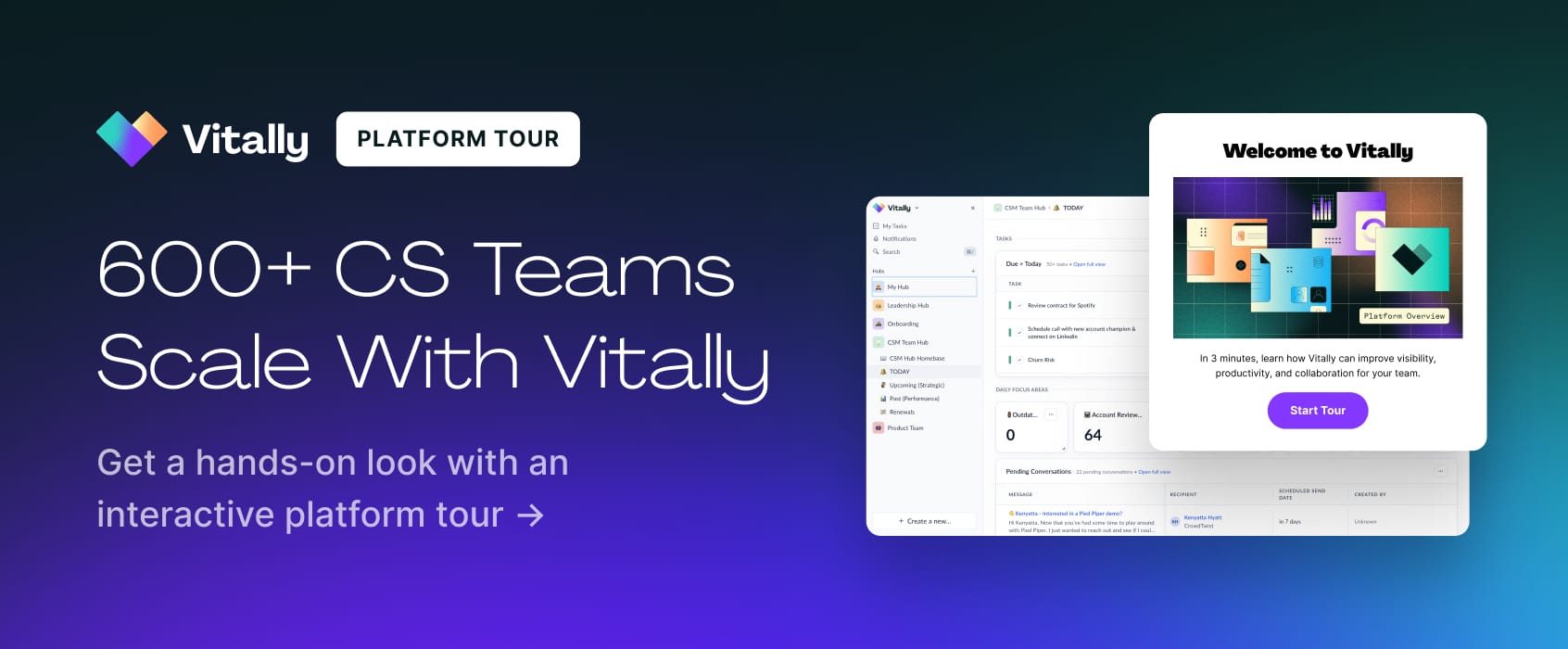
Having a solid implementation process is one of the best ways a SaaS company can kick off a long-term relationship on the right foot.
By demonstrating that you are attentive to your customer’s specific needs, you’re building trust, ensuring better adoption, and improving time to value for your clients — ultimately making them more likely to renew, refer, and expand!
So let’s talk about how to do implementation right. We’ve created this guide to Customer Success implementation as your back pocket tip sheet. We’ve gathered together a list of the most common steps and best practices, born from experience, from implementation experts across the industry that you can use to build a more effective implementation workflow.
What Is Implementation?
Implementation, in particular SaaS implementation, is the customization and roll-out of cloud-based software that enables businesses to rapidly deploy the new investment to their specific requirements so they can begin achieving value.
Implementation processes can include steps such as data migration, creating integrations with existing tech stacks, configuring and modifying the new software, adding custom objects and fields, setting up users, conducting tests, and adding company branding to the platform.
Implementation specialists, also known as Solutions Consultants or Solutions Engineers, are often the key contact within an organization to lead the process before handoff to a dedicated Customer Success Manager or Account Manager.
We Asked CS Experts: What Makes Implementation So Important?
“A well-executed implementation sets the foundation for a positive customer experience, reducing friction from onboarding through retention, and maximizing the value derived from the solution to empower the users of the software/solution.” — Abraham (Abe) Castro-Vela, Strategic Solutions Architect at Vitally
“Implementation is the foundation upon which success will be measured. Garbage in, garbage out. Set your customer up for success by fully understanding their wants and needs, configuring the system to align with those, and training your customer on how it all works.” — Cameron Micules, Marketing & Brand Strategist, Freelance
What’s the Difference Between Onboarding, Implementation, and Adoption?
It’s easy to get these three terms confused. We’ve all done it. The fundamental difference between SaaS onboarding, implementation, and adoption lies in their respective stages in the SaaS customer lifecycle.
Onboarding is your first post-sales process. From introducing the CSM team to first-time product walkthroughs, onboarding ensures every end user feels confident using your product themselves and knows they have an internal team available to offer them support and answer questions.
After onboarding, it’s on to implementation: deploying the product to the customer’s requirements. This is where dedication to your client really shows up. Delivering a product that is tailored to their needs and demonstrates you’re still around after the grand tour is a key way to establish trust.
“The goal is to get the customer implemented on your product to a ‘system ready’ state,” says Director of Customer Success & Digital Transformation Jason Carlin “After that, Customer Success can take the lead on the go-live journey. Treating an implementation as a set project with a defined endpoint helps the customer transition from implementation to a Live Customer state working with training, Customer Success, and support.”
Adoption comes next, and is much more aligned with Customer Success. This stage focuses on the ongoing and effective use of the software, making sure users are actually using the software they paid for, engaging with training and education, and maximizing long-term value as your solution becomes part of the organization's workflow.
As Fahmida Yasmin-Monium, a Vitally Solutions Architect, stresses, “Adoption is where you can strategically use the different feature sets of your product to shine in the eyes of your client, and positively impact your organization’s goals and OKRs."

The 4 Steps to a Successful Implementation
1. Have an Implementation Roadmap
An easily definable — and repeatable — game plan is critical to getting implementation accomplished in the most efficient way possible. That’s your roadmap: the timeline of milestones you intend to accomplish, always with dates attached, that you can present to your customer from the start.
Some of the common steps our experts include in their roadmaps are:
- Defining who the implementation team will be
- Explaining what the implementation phases will be
- Setting a meeting cadence
- Outlining training plans/materials
- Sharing an overall timeline
The faster you can get customers into the product so they can start seeing value, the better!
For Vitally users, we’ve developed this Implementation Guide Doc Template to increase your TTV and take the complexity out of your implementation process. Check it out!
2. Define Requirements
Separate from a kick-off call, this step includes gathering technical requirements, consulting with the client, and plotting the best possible solutions. Common milestones in this step would include:
- Customizing the Product. What sort of admin and governance structure does the client need? Which custom fields are required?
- Integrations. Customers will need to integrate several data sources with your product (or more accurately, you will). You’ll need to identify what’s in the tech stack your customer is using, and ensure your product is interacting with it properly.
- Data Transfer. Similar to integrations, you need to enable your product to access and pull from your customer’s data sources. Heads up! Once data is synced, you may be required to tweak your customizations again.
- Additional Tech Requirements. As you work with internal experts on training, you may discover additional hardware or software needs your customer may have to make full use of your product.
FYI: At Vitally, we’ll typically ask a customer to show up with a list of tools they’d like to integrate and identify a technical expert for consultations.
3. Create the Right Implementation Team
Determining what resources should make up your implementation team to ensure you accomplish the goals in the roadmap is vital. “Implementation is less of a hand-hold and more of a collaborative process because you have the technical teams on both sides of the sales equation working together,” says OpenText’s Christina Peden. “That’s why it’s key to identify and involve the right experts at this stage.”
Ask yourself: Do your Solutions Experts need to be more hands-on, or does the customer have a more capable internal IT team? How much education and training will be required, vs. providing materials and knowledge base access before handoff to Customer Success?
4. Encourage and Track Adoption
While this might largely involve handover to the CSM team, it’s still incumbent on you to ensure this step is smooth and complete.
As Cameron Micules points out, “Adoption is the work after the build, but you’re still leveraging your client implementation team to help the rest of the organization understand how the configured system will help them.”
<div id="item1" class="hidden-anchor"></div>
Best Practices for a Successful Implementation
Now that we’ve defined what makes a good implementation workflow, let’s get to the secret sauce. Here’s a roundup of tips and best practices from around the industry.
Build Your Own Map
Vitally’s Manager of Solution Architects, Zack Joswiak, stresses that your roadmap might start as a template, but it shouldn’t be an off-the-shelf solution. “Every team needs to define the implementation period based on their specific product and what the setup requirements are to lead to long-term success.”
Know Thy Customer
As Abe Castro-Vela notes, your customer's goals need to be top of mind from the jump. “Make sure you know what the must-haves, performance needs, and 'delighter' features and functionalities are for your customer before you start. This will help manage expectations — which is the number one factor in the measurement of customer satisfaction.”
Aim for a Seamless Transition
Celine Doumar, CSM at Vitally, explains in the CS Unleashed Webinar From Implementation to Success, it’s important to get your CSMs involved right from the kickoff call. “Some software has a lot of blank canvas. After set up, a customer doesn’t know where to go next. It’s up to us to make sure we’re guiding them, providing best practices, making sure they have the resources to be sure where to focus next.”
In addition to using post-sales and CS handover templates, Vitally customers can rest assured their long-term support and success reps are up to date and aware of their individual needs.
Clear Initial Roadblocks Fast
“You’d be surprised how many companies purchase a solution, have it installed in their environment, and then never end up using it,” says Christina Peden. “I believe this is where a good CSM comes in — to understand the customer's use case for the product and help them resolve any initial technical issues or hiccups they may be experiencing.”
Overcommunicate From The Start
With so many different stakeholders and specialists on your sales and CS teams, Jason Carlin reminds us, “The implementation contact may not have been on sales calls. Some high-level basics or a short demo video may be helpful. Keep in mind the emotional journey of the customer during these first steps, they need a little reassurance and communication on what's to come.”
Think Big, Act Small
Abe suggests making your build-out like building blocks. “Be an architect and design beautiful and scalable solutions, but remember to break that down into the smallest, interoperable parts you can while building. Think of it as LEGOs: Each brick is a module. Arrange enough of them in a particular order to build a component. Then arrange and integrate those components to provide a final product.”
Walk, Don’t Run
“Assessing all the possible solutions is important before diving in and using any product you purchase,” Fahmida often reminds her customers. “It can be tempting to get all things done when we’re excited about using a new tool, but there are steps to success. Getting expert input and working together with your provider will ultimately set you up for a much more positive journey ahead.”
First Impressions Matter
“Your sales team might be able to make a great pitch to the customer and close the deal,” says Christina Peden, “but that all goes out the window if the first experience the customer has with you post-sale is a poorly executed implementation. That experience will color, and perhaps sour, the customer's opinion of your company going forward, making it 10x harder for your CSM to win them back over once the implementation is complete.”
She recommends you:
- Have a proper channel for communication with clients
- Ask for feedback
- Be available
- Celebrate goals
Stay Hands-On Until Handoff
“You can't simply ‘hand off’ implementation to a client to do,” says Cameron Micules. “Even if they’ve identified their super-user or client-solution champions, they're not as invested as you are. Work with them. Help them. Make their job as easy as possible so they enjoy it. Don't leave the success of your solution in the hands of someone who doesn't work for you.”
Make Your Mark With Amazing Implementation
Zack’s experience has led him to an important point that we like to stress to all our customers. “Implementation is a vital step in a customer's journey. They just made a big decision to purchase your tool, and now are looking to their implementation specialist to help bring the ideas and visions they have around your tool to life. Having a standardized implementation plan you can share with them will help them understand the work ahead, and also give them the confidence that you've done this before.”
With automated processes and integrated products like Projects and Notes, Vitally is used by companies all over the globe to create and manage best-in-class customer implementation workflows. Not a Vitally customer yet? Request a personalized demo of Vitally with one of our Customer Success experts today and learn how our top-rated Customer Success Platform can help your CS organization drive better customer outcomes at every stage of the relationship.







